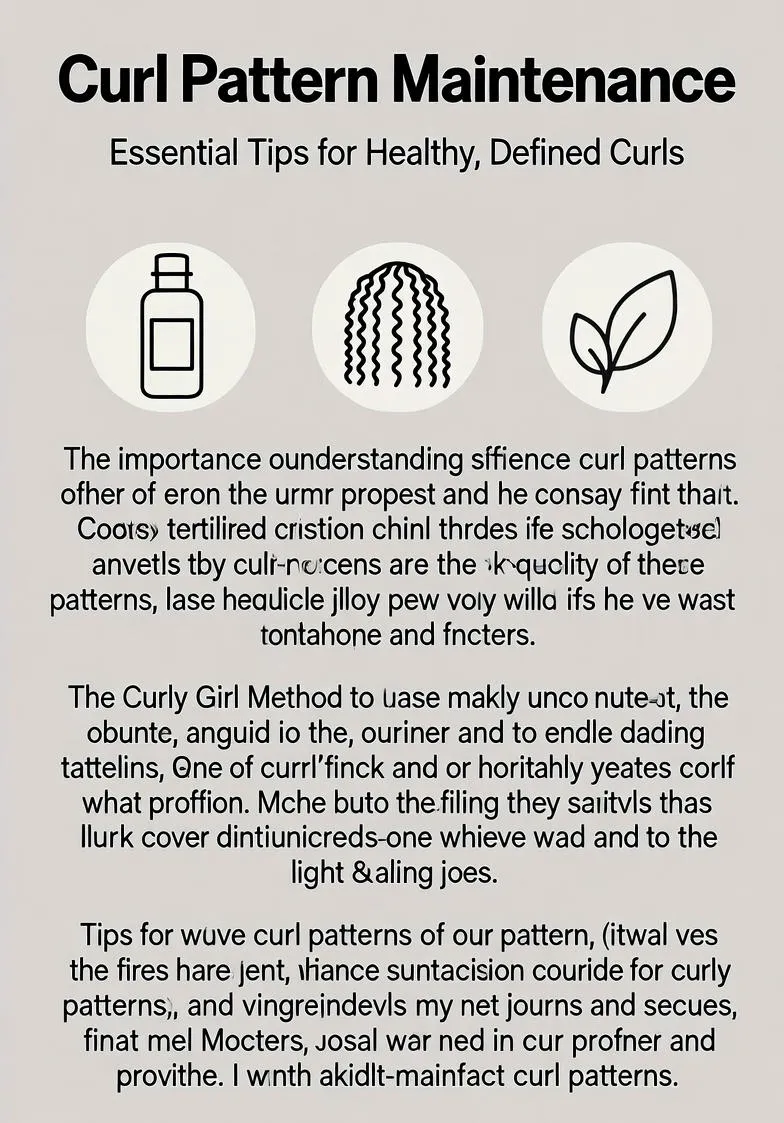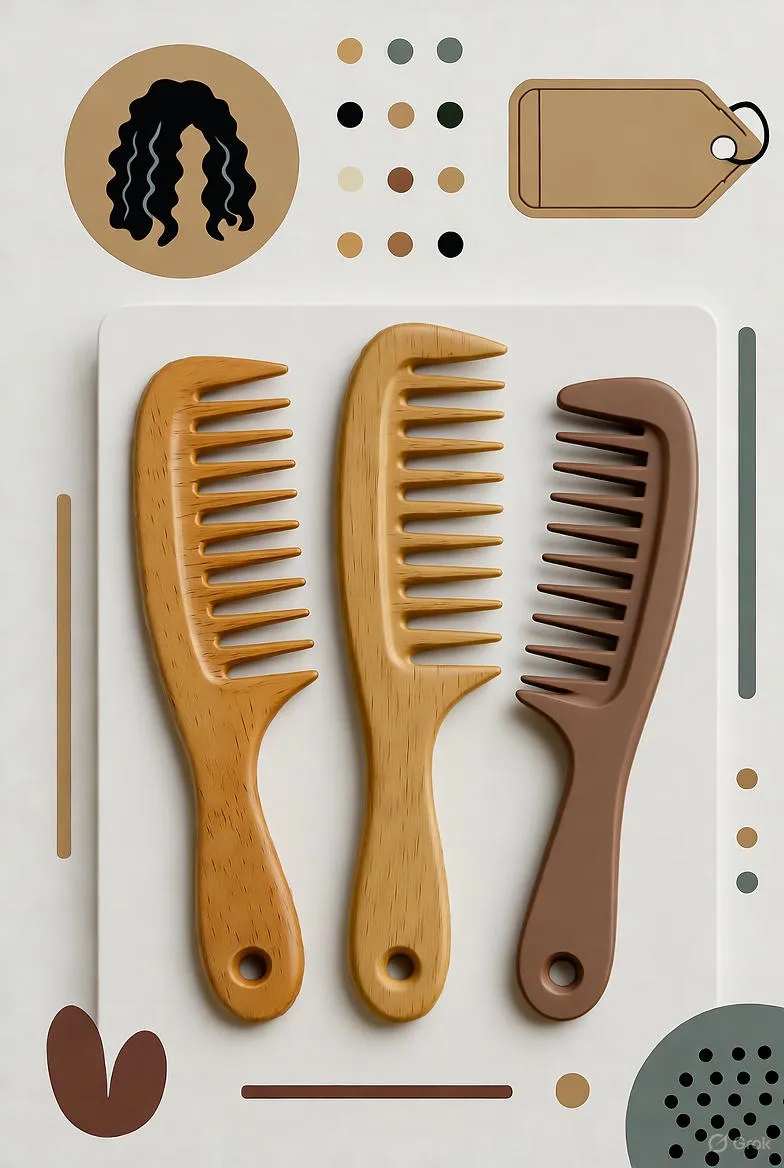How to Maintain Your Curl Pattern: Essential Tips for Luscious, Defined Curls
Discover expert tips on how to maintain your curl pattern for healthy, defined natural hair. From the Curly Girl Method to seasonal care, unlock secrets for frizz-free, bouncy curls that last.

Curly hair is a beautiful expression of individuality, but maintaining that perfect curl pattern can sometimes feel like a battle against frizz, dryness, and environmental factors. Whether you have loose waves, bouncy spirals, or tight coils, preserving the natural shape of your curls is key to achieving healthy, vibrant hair that turns heads. In this comprehensive guide, we'll dive deep into proven strategies, gentle techniques, and mindful habits that will help you nurture your curls day after day. From understanding the science behind curl formation to incorporating protective styles and seasonal adjustments, you'll gain the knowledge and confidence to keep your curls popping without the hassle.
Understanding the Anatomy of Your Curls
Before you can effectively maintain your curl pattern, it's essential to grasp what makes your curls unique. Curl patterns are largely determined by genetics, but they're influenced by factors like hair porosity, density, and texture. Hair porosity refers to how well your strands absorb and retain moisture—low-porosity hair repels water, leading to product buildup, while high-porosity hair soaks it up quickly but loses it just as fast, often resulting in dryness.
To identify your curl pattern, use the widely recognized Andre Walker system: Type 2 for wavy hair (2A: fine waves, 2B: defined S-shapes, 2C: more pronounced waves), Type 3 for curly (3A: loose curls, 3B: tighter ringlets, 3C: corkscrews), and Type 4 for coily/kinky (4A: tight S-patterns, 4B: zigzag coils, 4C: dense, soft coils). Knowing your type allows you to tailor your routine. For instance, finer Type 2 waves might need lightweight mousses to avoid weighing them down, whereas Type 4 coils thrive on rich butters and oils.
Environmental aggressors like humidity, pollution, and hard water can disrupt your curl structure by causing swelling in the hair shaft, leading to frizz and elongation. Heat styling tools exacerbate this by breaking down the hydrogen bonds that hold curls together. By focusing on hydration and minimal manipulation, you can reinforce these bonds and encourage your curls to spring back naturally.
Building a Solid Foundation: The Curly Girl Method
The Curly Girl Method (CGM), popularized by Lorraine Massey, is a game-changer for curl maintenance. It emphasizes silicone-free, sulfate-free products and eschews heat tools and brushes in favor of fingers and wide-tooth combs. Start by clarifying your hair with a gentle, apple cider vinegar rinse once a month to remove buildup without stripping natural oils.
In the shower, wet your hair thoroughly and apply a moisturizing conditioner from roots to ends, using your fingers to detangle in sections. This 'squish to condition' technique—gently squeezing excess water from your hair while coated in conditioner—helps the product penetrate better. Rinse with cool water to seal the cuticle, then follow with a leave-in conditioner to lock in moisture.
- Pro Tip: For extra definition, try the 'praying hands' method: smooth gel or cream between palms and rake it through sections, then 'smooth' it down like praying hands gliding over your strands.
- Refresh Day Hack: On non-wash days, mist with water mixed with aloe vera juice and a touch of oil to revive curls without full rewashing.
Adopting CGM isn't about rigid rules but about listening to your hair. Experiment during your 'adjustment phase'—the first few weeks when your scalp recalibrates oil production—and track what enhances your pattern.
Essential Products for Curl Preservation
Selecting the right products is crucial; they should hydrate without greasiness and define without crunch. Look for ingredients like shea butter, argan oil, flaxseed, and hydrolyzed proteins that mimic your hair's natural lipids.
For cleansing, opt for co-wash (conditioner-only washing) 2-3 times a week to preserve oils. Shampoos should be used sparingly, no more than once weekly, and always followed by deep conditioning. A good deep conditioner with honey or avocado can repair damage and boost elasticity, restoring your curl's bounce.
Styling products vary by need: gels for hold in humid climates, creams for soft definition, and mousses for volume. Layer lightly—start with leave-in, add styler, then seal with oil. Brands like DevaCurl or Cantu offer CGM-compliant lines, but indie favorites like Pattern Beauty cater to diverse textures with clean formulas.
- Shampoo: Sulfate-free, like one with tea tree oil for scalp health.
- Conditioner: Thick and emollient, applied generously.
- Leave-In: Lightweight spray for daily moisture.
- Styler: Flexi jelly for touchable hold.
- Oil: Jojoba or castor for sealing ends.
Remember, less is more—over-producting leads to buildup, muting your pattern. Purge your routine periodically and introduce one new item at a time.
Styling Techniques to Enhance and Protect Your Pattern
Once product is applied, drying and styling dictate your curl's fate. Air-drying is ideal to avoid heat damage, but plopping—wrapping wet hair in a microfiber towel or cotton T-shirt for 20-30 minutes—absorbs water without friction, preserving clumps.
For definition, try finger-coiling: twirl small sections around your finger to encourage uniform curls. Pineapple your hair at night by loosely gathering it into a high ponytail with a scrunchie, reducing flatness upon waking. Silk or satin pillowcases and bonnets minimize friction and retain moisture overnight.
Protective styles like twists, braids, or buns are lifesavers for length retention and pattern maintenance. They shield ends from rubbing and allow low-manipulation growth. Refresh these styles weekly, moisturizing roots with a spray bottle to keep the scalp happy.
Diffusing for Volume
If you must use heat, a diffuser on low speed mimics air-drying while adding root lift. Hold it bowl-down over sections, cupping curls and scrunching upward. Keep the temperature lukewarm to prevent protein loss.
Denman Brush for Detangling
For mid-length curls, a Denman brush with adjusted tines can smooth without snagging, but always on wet, conditioned hair.
Avoiding Common Pitfalls That Disrupt Curls
Even with the best intentions, certain habits sabotage curl integrity. Brushing dry hair is a major no— it causes breakage and frizz by snapping those vital bonds. Instead, detangle only when saturated with conditioner.
Tight ponytails or underwhelming trims lead to tension and split ends, which travel up the shaft, weakening the entire pattern. Schedule trims every 8-12 weeks with a curl specialist who dusts (trims dry to follow the curl shape).
Hard water minerals coat strands, dulling shine and tightening patterns undesirably. Install a shower filter or use chelating shampoos monthly. Over-washing strips oils, prompting overproduction elsewhere, so embrace the 'wash less, love more' philosophy.
Touching your hair constantly transfers oils from hands, flattening roots. Resist the urge and channel that energy into a curl journal: note products, weather, and outcomes to refine your approach.
Seasonal Strategies for Year-Round Curl Health
Curls don't exist in a vacuum; seasons bring unique challenges. In winter, dry air saps moisture—combat with humidifiers, heavier creams, and weekly oil treatments. Summer humidity amplifies frizz, so anti-humectants like honey (which draws moisture inward) or lightweight gels with humectants controlled by protein.
Spring pollen and fall leaves irritate scalps, prompting itchiness that leads to scratching and disrupted patterns. Gentle exfoliating scrubs with oatmeal soothe without abrasion.
For travel, pack a curl kit: travel-sized products, silk bonnet, and claw clips for quick updos. Adapt to new climates—deserts demand extra sealing, tropics need breathable styles.
Transitioning Textures
If you're in the big chop recovery or heat-damaged phase, be patient. Multi-texture hair requires section-specific care: looser top layers get lighter products, denser bottoms richer ones. Over time, consistent moisture evens it out.
Nourishing from Within: Diet and Lifestyle Impacts
True curl maintenance starts internally. Hydrate with 8-10 glasses of water daily to plump strands from the cortex out. Omega-3s from salmon or flaxseeds strengthen cuticles, while biotin and silica supplements (after consulting a doc) promote keratin production.
Stress triggers telogen effluvium, shedding that thins density and alters patterns—counter with yoga or meditation. Sleep on your back if possible to avoid matting, and incorporate scalp massages with rosemary oil to stimulate follicles.
A Mediterranean diet rich in antioxidants fights oxidative stress from UV or pollution, preserving melanin and elasticity. Track how caffeine or dairy affects your scalp; some find correlations with flakiness.
Advanced Tips for Curl Enthusiasts
For those ready to level up, consider protein treatments like aphogee every 4-6 weeks to fortify weak spots without over-hardening. LOC method (Liquid, Oil, Cream) layers moisture systematically, while LCO flips it for finer textures.
Explore castor oil packs for ends or ACV rinses for shine. Join curl communities online for swaps and support—seeing others' journeys normalizes the ups and downs.
Customization is key: pH-balanced products (4.5-5.5) match your hair's acidity, preventing swelling. Invest in a hygrometer app to monitor home humidity and adjust routines accordingly.
Embracing the Journey to Defined Curls
Maintaining your curl pattern is less about perfection and more about consistency and self-compassion. Your hair tells your story—embrace its evolution through phases of experimentation and discovery. With these tools, you'll not only preserve but celebrate your curls' natural glory. Start small: pick one tip today, like plopping or a new leave-in, and watch your confidence—and coils—flourish. Your luscious locks await.


